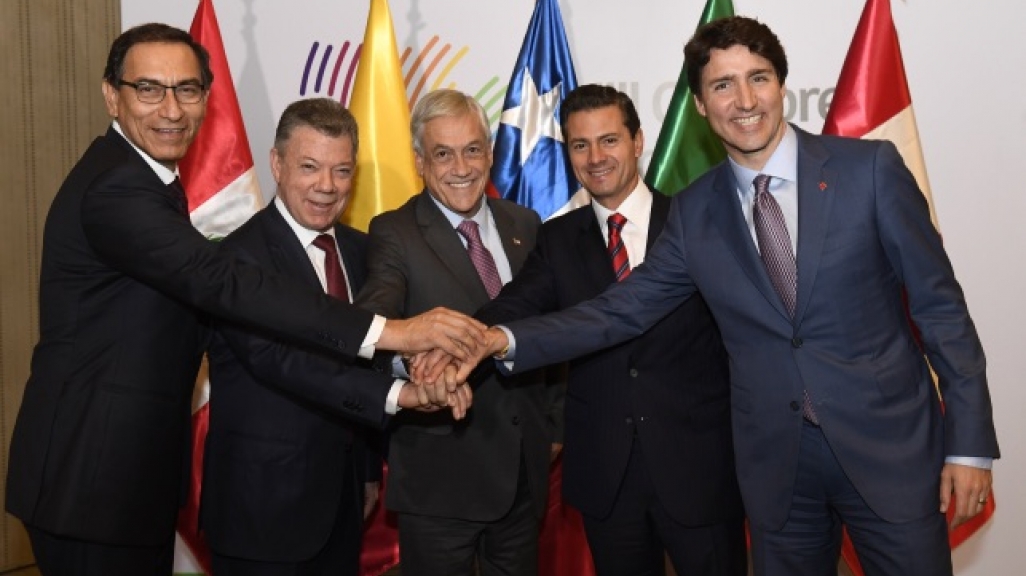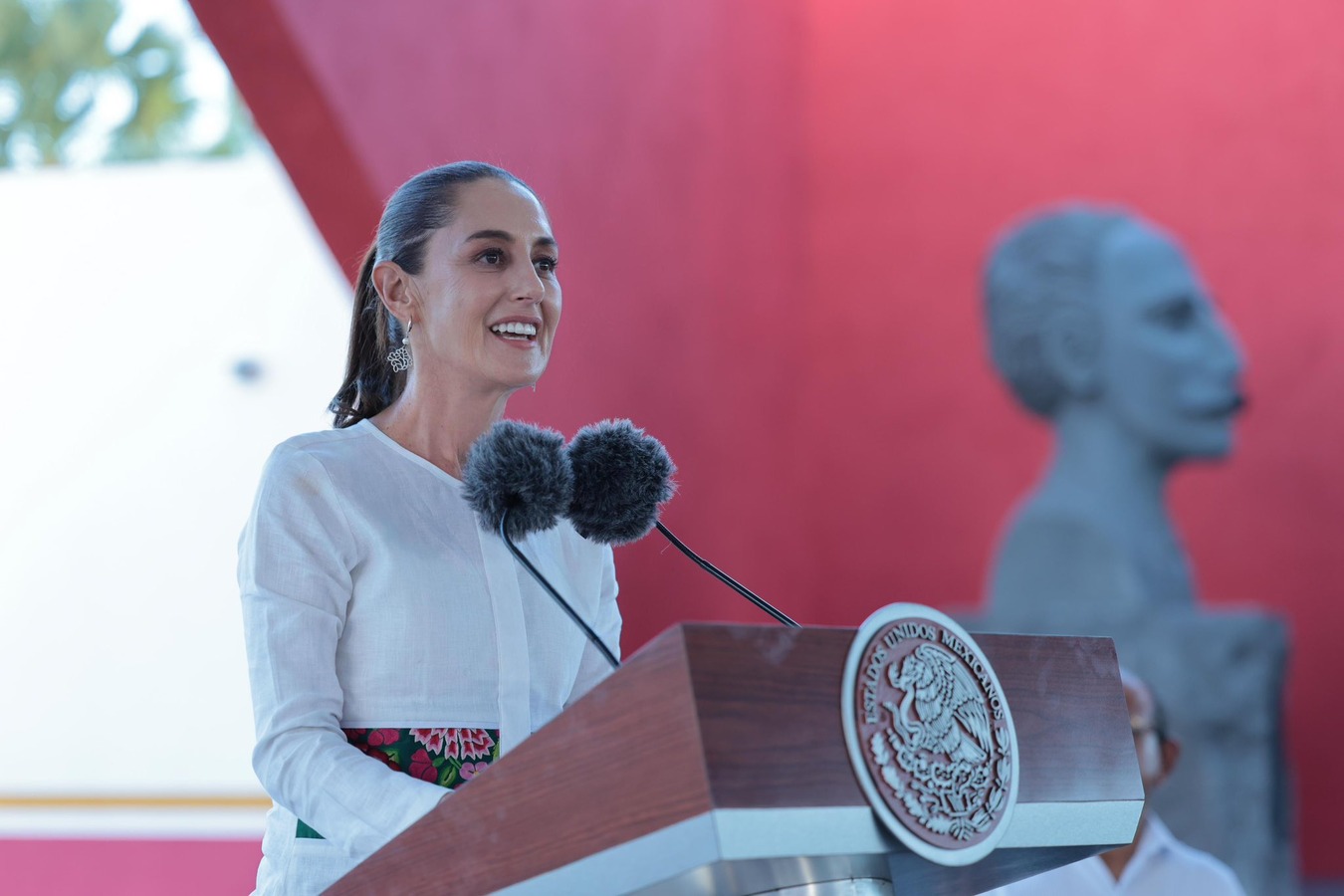Explainer: What Is the Pacific Alliance?
Explainer: What Is the Pacific Alliance?
With an eye toward Asia, this Latin American group is looking to increase trade and integration among members.
Updated July 23, 2018—One of the newest economic blocs to emerge from Latin America, the Pacific Alliance is designed to create a regional gateway to Asian markets. Composed of Chile, Colombia, Mexico, and Peru, the bloc's members are pursuing commercial, economic, and political integration. The group accounts for more than one-third of Latin America’s GDP and exports about 92 percent more than the Southern Common Market (Mercosur) bloc.
While only seven years old, the Pacific Alliance’s members have taken strides to liberalize trade, focusing on openness to foreign investment and the integration of a common market.
AS/COA Online details the Alliance’s Framework Agreement, origins, members, and goals.
Browse by topic:
- Origins and Goals
- Members of the Alliance
- Organizational Institutions
- Goals and Progress of the Alliance
|
The Latest Outgoing Mexican President Enrique Peña Nieto will host his counterparts for a summit in Puerto Vallarta on July 24 and 25, during which Mexico will accept the bloc’s rotating pro tempore presidency from Colombia. The summit follows a meeting between the four member countries’ finance ministers, in which the officials discussed regulating financial technology and drew plans for a Pacific Alliance collective investment vehicle. By the end of 2018, all four member states will have experienced transfers of power. In March, Chilean President Sebastián Piñera succeeded Michelle Bachelet, and Martín Vizcarra became Peru’s president following Pedro Pablo Kuczynski’s resignation. On August 7, President Juan Manuel Santos will step down, with Iván Duque taking over, and on December 1, Andrés Manuel López Obrador (AMLO) will become Mexico’s president. In addition to the four leaders from the Alliance, Mercosur presidents and 250 entrepreneurs and 50 government officials from Alliance countries will attend the summit. Instead of presidents, Paraguay and Argentina will send their vice ministers of foreign affairs, while Argentina will also send its ambassador to Mexico. Santos indicated that the bloc will finalize Canada, Australia, Singapore, and New Zealand’s status as associate members, in addition to beginning the process of integrating South Korea for associate membership. |
The Alliance was informally created on April 28, 2011, when the presidents of Chile, Colombia, Mexico, and Peru signed the Lima Declaration. This initiative was developed by then-Peruvian President Alan García to supplement the existing bilateral trade agreements between the four countries and create an economic bloc to negotiate and trade with other economies as a unified group. The Alliance’s goal was to increase competitiveness by integrating economies and allow for the free flow of capital, goods, people, and services among members, in addition to seeking expanded trade with Asia-Pacific countries.
On June 6, 2012, the bloc officially launched when the four countries’ presidents signed the Pacific Alliance Framework Agreement at the Fourth Summit of the Pacific Alliance in Antofagasta, Chile.
The Alliance members—Chile, Colombia, Mexico, and Peru—are responsible for approximately 38 percent of Latin America and the Caribbean’s total GDP, receive 37 percent of Latin America’s foreign direct investment, and make up approximately 59 percent of the region’s trade.
The Framework Agreement dictates that member countries must be democracies, practice separation of the powers of state, and protect, promote, and guarantee human rights and fundamental liberties. They must also have existing bilateral trade agreements with member countries. Article 3 of the Framework Agreement outlines requirements for countries seeking membership. The bloc aims to sign free trade agreements (FTAs) with Asia-Pacific countries based on existing bilateral trade accords.
Canada, Singapore, Australia, and New Zealand are in the process of becoming associate members of the alliance, while Costa Rica and Panama have been negotiating to become official members. However, after signing the Framework Agreement and beginning the path to full membership in 2013, Costa Rica’s government slowed its accession process due to concerns surrounding the impact the Alliance might have on the country’s agricultural sector. The nation’s new president, Carlos Alvarado Quesada, campaigned against Costa Rica joining and said he would negotiate a better deal on behalf of the country’s agricultural and industrial sectors.
Panama penned an FTA with Mexico on April 2, 2013, allowing the country to receive its Alliance “entry ticket” since it already has pacts with Chile, Colombia, and Peru. A tariff disagreement has been the main obstacle to Panama’s accession, but in a 2017 meeting with then-Chilean President Michelle Bachelet, Panamanian President Juan Carlos Varela reasserted his country’s desire to join the bloc.
In June 2018, Ecuador formally requested to become an official member, while the United Arab Emirates, Belarus, and Serbia asked to become observer states.
- High-Level Group: To accomplish the Alliance’s goals, the Lima Declaration established a High-Level Group (GAN) made up of member countries’ ministers and vice ministers of commerce, trade, and foreign affairs. Officials also serve as national coordinators and operate in 26 technical groups covering a range of issues, including innovation, labor, mining development, intellectual property, the environment, and culture. Groups hold meetings to evaluate and discuss progress or changes within their areas. The Inter-American Development Bank provides technical assistance to these groups upon request.
- Observer Countries: As of the 2018 summit, there are 55 observer countries. In addition to official members, current observer nations in the Americas include Canada, Costa Rica, Panama, Ecuador, Argentina, the Dominican Republic, El Salvador, Guatemala, Haiti, Honduras, Paraguay, Trinidad and Tobago, the United States, and Uruguay, making them candidates for future membership. In 2018, Honduran President Juan Orlando Hernández expressed his desire that his country join the bloc as a member. Beyond the Western Hemisphere, countries as diverse as Australia, Egypt, Germany, India, Israel, Japan, Spain, and the United Kingdom are among the 55 observer nations.
- The Pacific Alliance Business Council was established at the first meeting of the Pacific Alliance’s GAN in August 2012. The Council comprises businesspeople from member countries who meet to further private-sector integration.
- Inter-Parliamentary Commission: On May 6, 2013, heads of legislatures from Alliance member countries signed an agreement to form a Pacific Alliance Inter-Parliamentary Committee. This body develops legislation to approve Alliance trade agreements.
- Council of Finance Ministers: Established in the 2015 Paracas Declaration, the Council of Finance Ministers works toward financial integration between Alliance countries as well as investing in infrastructure and fiscal transparency and managing natural disaster risk.
Goals and Progress of the Alliance
- Trade: Alliance members keep a network of trade agreements between each other and additional countries to promote international commerce, foreign investment, innovation, and technological exchange. At the GAN working meeting in January 2013, the Alliance agreed to reduce inter-member tariffs to 10 percent by March 31, 2013. In 2016, member countries adopted an agreement cutting tariffs on 92 percent of imports and exports, with the other 8 percent to be phased out in the following three to 17 years.
- Migration: With a combined population of approximately 228 million people, member countries have made advancements toward the free movement of people. Not only does this promote members’ tourism industries; it also increases the international competitiveness gained through academic and business exchange. In November 2012, Mexico exempted Colombian and Peruvian residents from visas for stays of up to 180 days (Chile has been exempt from this requirement in Mexico since 1991). Visa requirements between Costa Rica and Peru were lifted in 2015. The Alliance also implemented a joint system to provide 100 annual university scholarships to promote student exchange, eliminated transit visas, and began talks to create a single passport for member countries.
- Integrated Financial Markets: The Latin American Integrated Market (MILA) is the joint stock exchange between Chile, Colombia, Peru, and Mexico. In pursuit of financial integration, the four member countries combined their financial markets into a single bourse, or stock market. Since May 2011, Chile, Colombia, and Peru have used MILA to conduct cross-border trading between companies. Mexico became an official member of MILA in 2014.
- Multilateral Ties: The Alliance is expanding connections with other regions. At the Community of Latin American and Caribbean States (CELAC)-EU Summit in January 2013, Alliance member countries held bilateral meetings and signed agreements with European leaders in an effort to deepen ties to European markets. At the time, Chile signed pacts with Brazil, Germany, and Spain. The Alliance and the European Union reaffirmed their relationship in a joint statement on July 17, 2018. With the exception of Colombia, Alliance members are also part of the Comprehensive and Progressive Agreement for Trans-Pacific Partnership (CPTPP), the free trade agreement between 11 Asia-Pacific countries that developed after the United States withdrew from the Trans-Pacific Partnership (TPP). In 2017, leaders from the eight Mercosur and Pacific Alliance states met to develop a plan for possible integration between the two blocs.
Celeste Castillejo, Rachel Glickhouse, and Brian Harper contributed to this article.









